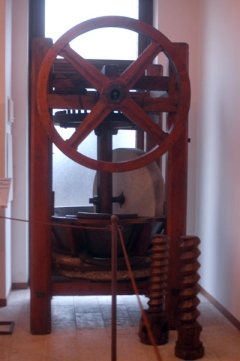Lake Garda: Oil you need to know
Italian museum tells of olive region’s pressing matters

View Gallery (5 images)
The towns hugging the shore of Italy’s Lake Garda provide all kinds of diversions for all kinds of people.
Along the main drag, through Bardolino, Lazise and Peschiera, are: Gardaland, “Italy’s largest amusement park”; Movieland Studios; several water parks; a jungle park adventure with suspended rope swings and ladders; and a safari experience enjoyed from the comfort of your automobile.
Add that to all the great food, good and cheap wines, medieval fortresses and terrific views of the area, and what you’ve got is a holiday, especially in summer when you can also swim in the lake.
In winter, though, the lake is cold, some of the tourist attractions are shut and others are available but less fun on a chilly December day. But somewhere between the kitsch and the culture is a welcoming spot most days of the year. It aims to inform visitors to this region abounding in olive trees all about olive oil — more than they ever dreamed it was possible to know — and then to sell them a bunch of it.
Some Vicenza residents make an annual pilgrimage to the Museo dell’Olio d’Olivia to gaze at the giant, antique olive oil presses and fiber baskets, and to stock up on the oil sold in the museum shop. Others might wonder why they should care how olives are harvested (into nets!). And why is there not even a mention of Popeye’s girlfriend?
The museum, opened in the 1980s by an olive oil-producing family, contains a collection of antique equipment used to produce olive oil in the 18th century, including a massive oak lever press and a water-wheel-driven mill still in working order.
Visitors learn that the massive stones once used to crush the olives to make a paste that precedes the oil are still used by many olive oil producers today.
There is also a room that shows videos on the history of olive oil, its methods of production and many uses to visitors — some 50,000 a year, according to the museum brochure.
After a busload of Germans cleared out of the room, we chose the English-language version. In the voice-over, a woman with a plummy British accent told us that olives are a fruit, that Lake Garda is the most northerly place olives are cultivated and that the crop is a pillar of the Lake Garda economy.
She told us that olive-growing originated in Syria and then went to Greece via the Phoenicians and later to France, Spain and Portugal via the Romans.
We also learned that the Greeks used olive oil to cook, light lamps, massage themselves and others, and as an insulator for doing battle in cold water.
Moreover, we learned that olive oil fell into decline during the Middle Ages and was used for a long time primarily for lighting lamps in cathedrals.
Monks finally brought it back for cooking in the middle of the Middle Ages, the video said, but people in the United States didn’t start using it until the 1960s — or in my family’s case, never.
Nowadays, the video said, olives are grown in the U.S., and people everywhere know that olive oil “aids digestion and combats cardiovascular illness.”
So we bought four bottles. We also bought a case of pesto, three jars of tomato sauce, a cheese grater, two wooden mortars and pestles and a dozen olive oil soaps.
On the QT
Directions: Museo dell’Olio d’Oliva is at Via Peschiera, 54 37011 Cisano di Bardolino, on the main lakeside road, the S249. Exit autostrada A4, running east-west between Venice and Milan, at the Peschiera del Garda junction and follow S249 north. From A22, running north-south, take the Affi exit and head west toward the town of Garda on the lake. At Garda, turn south onto the S249.
Times: The museum is open 9 a.m. to 12:30 p.m. and 2:30 to 7 p.m., Monday through Saturday; Sunday and holiday hours are 9 a.m. to 12:30 p.m. It is closed Sundays in January and February, and on Easter, Christmas, Dec. 26, Dec. 31, Jan. 1 and Aug. 15, plus Jan. 15-31.
Costs: Free admission but must pass through shop with irresistible foodstuffs for sale to exit.
Food: Cafes and restaurants are all over the place in the towns along the lake, although many are closed in winter.
Information: The museum Web site is www.museum.it (there is an English version), and its telephone number is (+39) 045- 6229047.
— Nancy Montgomery










